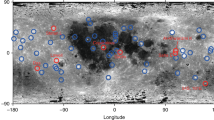Abstract
Crater density determinations for parts of the surfaces of several of Saturn's icy satellites including Rhea, Dione, Mimas, Tethys and 1980S3 reveal significant variations. These data, combined with observations of surface morphology, indicate that each satellite has undergone extensive post heavy bombardment geological evolution.
Similar content being viewed by others
References
Smith, B. A. et al. Science 212, 163–191 (1981).
Smith, B. A. et al. Science (in the press).
Consolmagno, G. & Lewis, H. Icarus 34, 280–293 (1978).
Owen, T. (in preparation).
Shoemaker, E. & Wolfe, R., Abstr. 12th Lunar planet. Sci. Conf. Suppl. A, 1–3 (1981).
Shoemaker, E. & Wolfe, R. in The Satellites of Jupiter (ed. Morrison, D.) (University of Arizona Press, in the press).
McKinnon, W. B. EOS 62, 318 (1981).
Peale, S. J., Gassen, P. & Reynolds, R. T. Icarus 43, 65–72 (1980).
Johnson, T. V. & McGetchin, T. R. Icarus 18, 612–620 (1973).
Author information
Authors and Affiliations
Rights and permissions
About this article
Cite this article
Plescia, J., Boyce, J. Crater densities and geological histories of Rhea, Dione, Mimas and Tethys. Nature 295, 285–290 (1982). https://doi.org/10.1038/295285a0
Received:
Accepted:
Issue Date:
DOI: https://doi.org/10.1038/295285a0
- Springer Nature Limited
This article is cited by
-
Effects of the External Environment on Icy Satellites
Space Science Reviews (2010)
-
Cassini Radio Science
Space Science Reviews (2004)
-
The topography of Epimetheus
Earth, Moon, and Planets (1993)
-
The topography of Janus
Earth, Moon, and Planets (1993)





